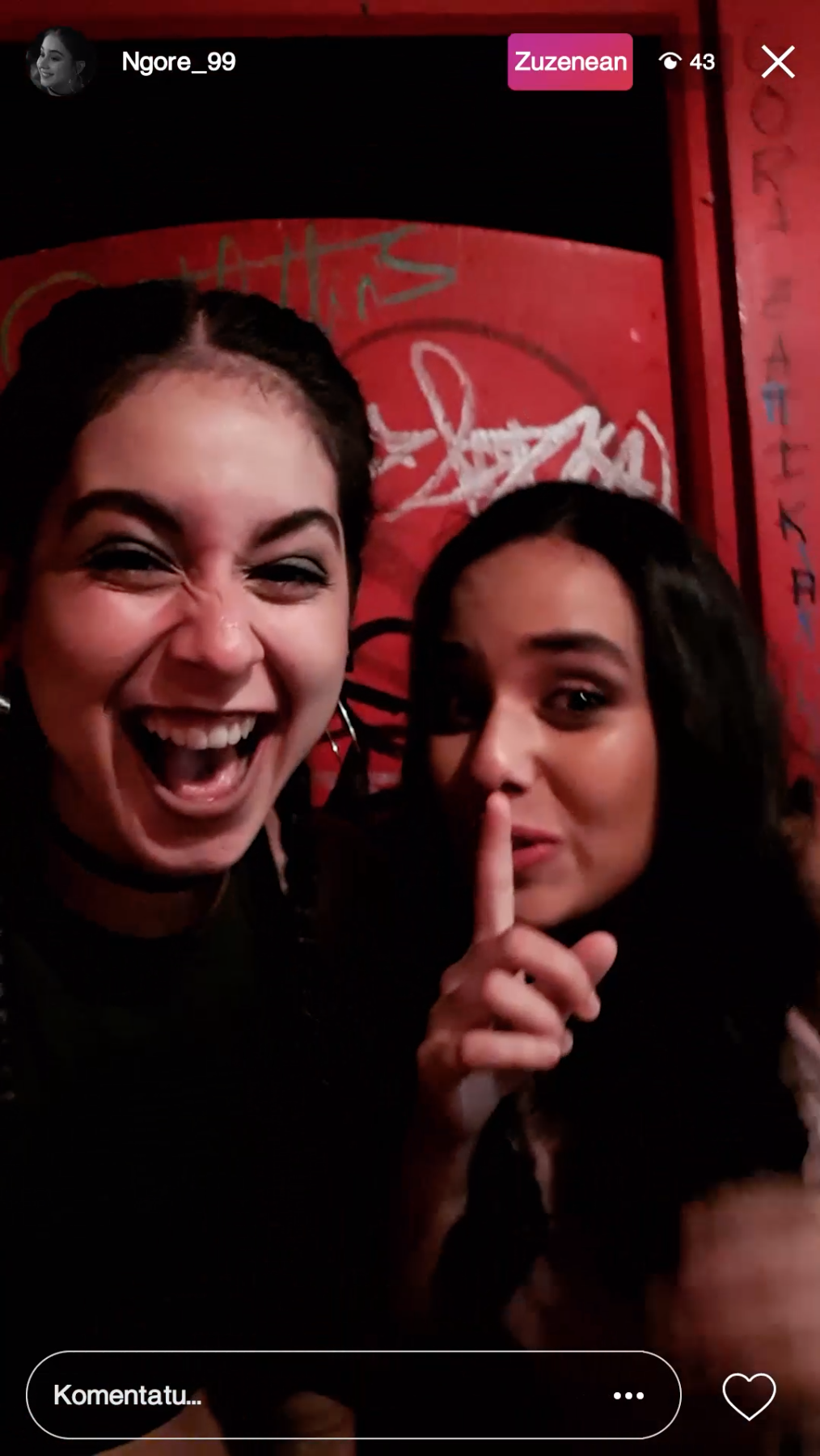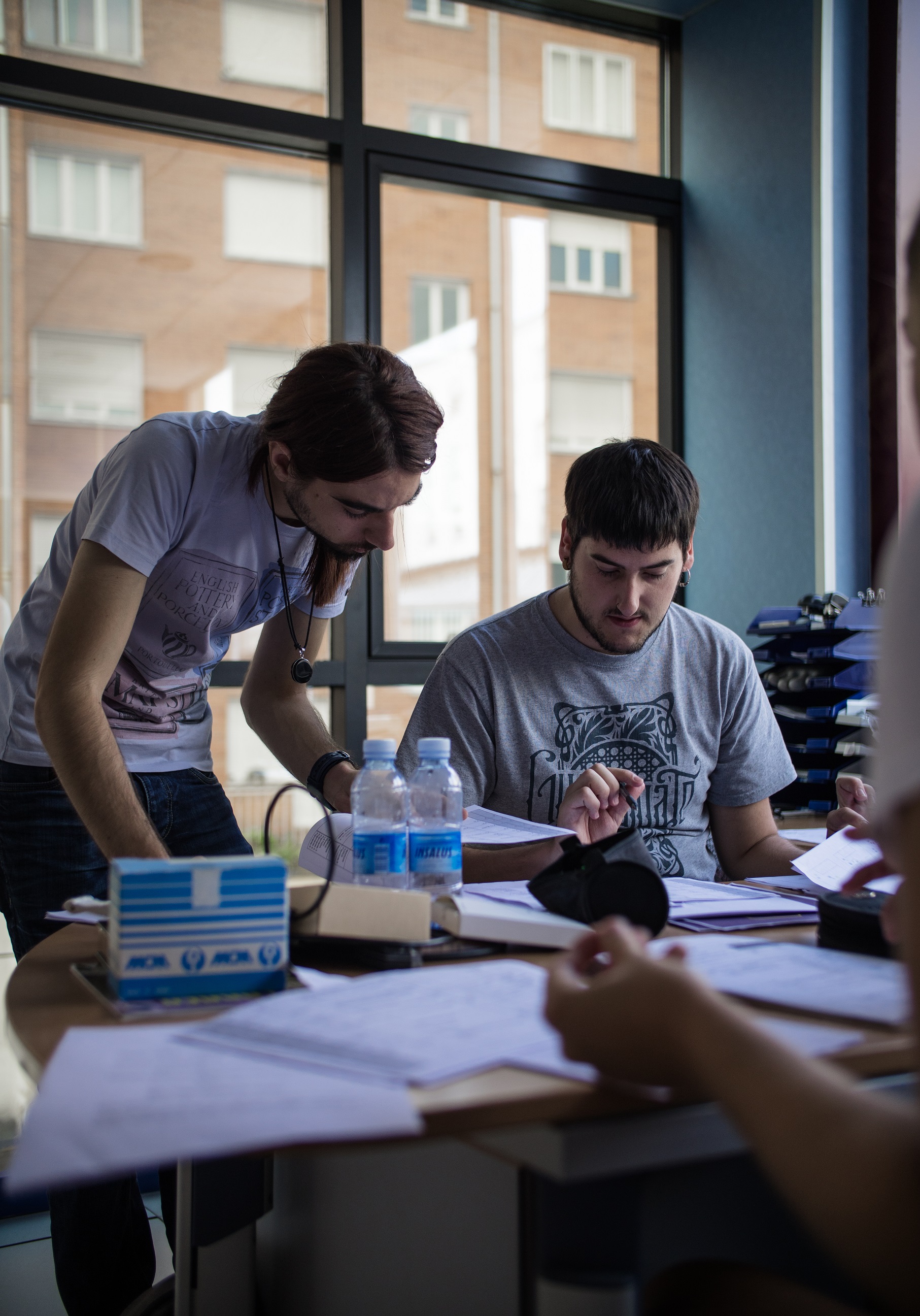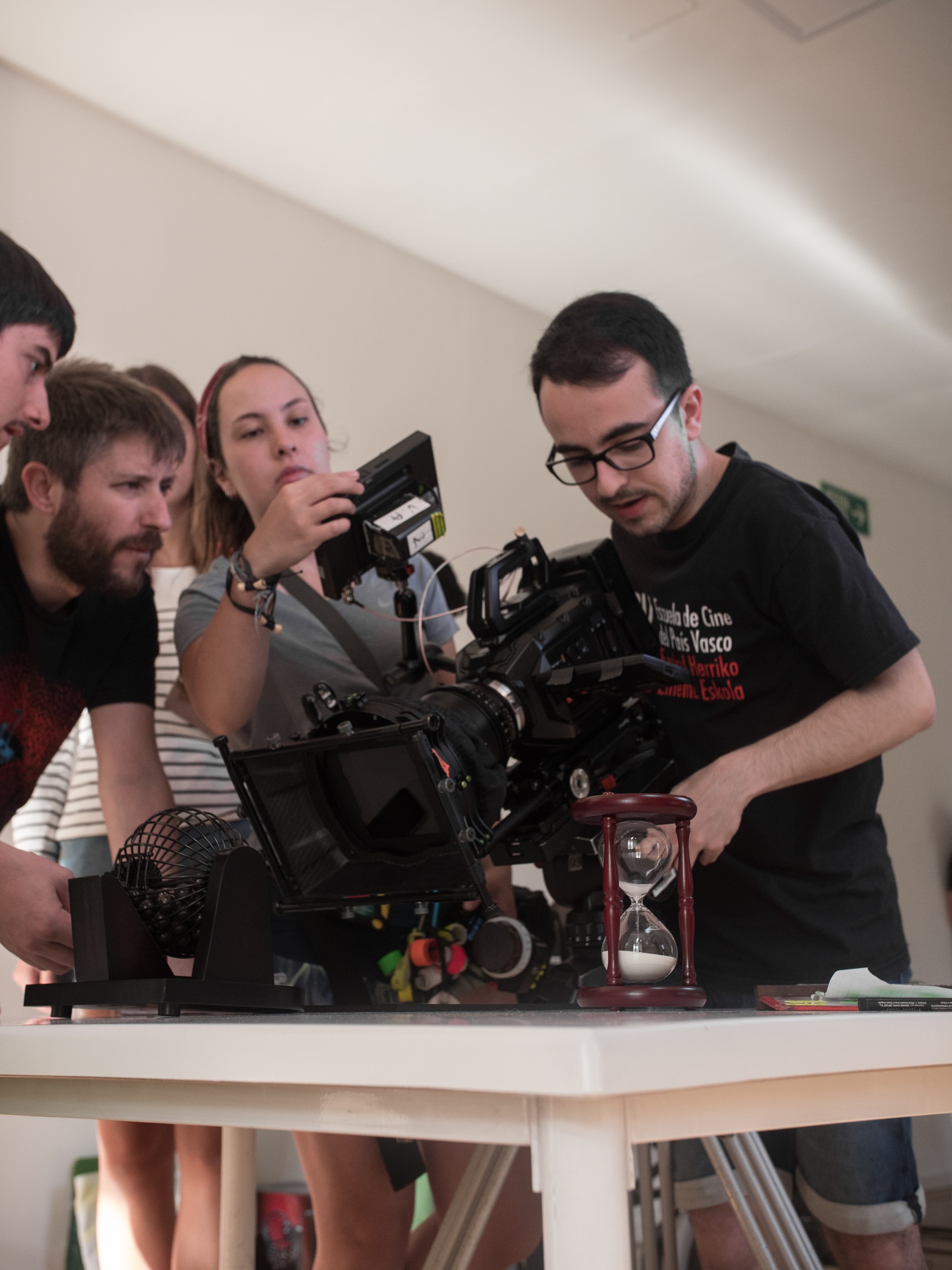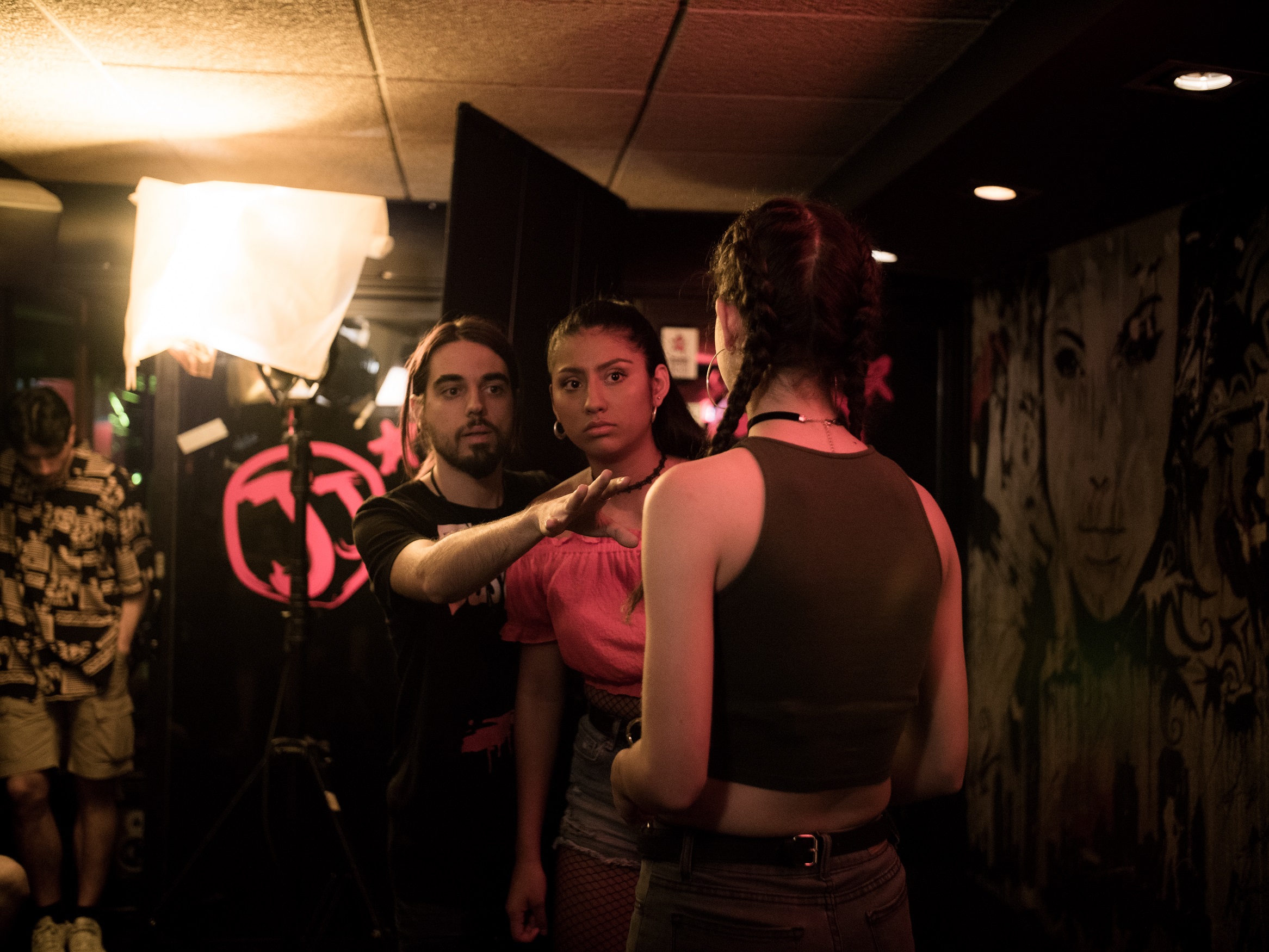
The first episode takes place in the nightlife. It is not immediately obvious what the evening will lead to. Still, a certain tension is created, and the musical background and the camera work, which does not allow the viewers to guess what will happen in the next few minutes. Because of the few main actresses, the viewer’s focus is on what happens between the two, Iratxe and Nagare. The epi-sode thematises on parties, where forced sexual acts are secretly filmed and then spread on the in-ternet. In a short time, the mood of the two main characters changes when they realize that what they filmed with their cell phones is harmful and should not be spread. As a result, they part in a quarrel.
In the second episode, a woman is accompanied while shopping in the supermarket. The camera follows her around—a little boy, who appears to be her son, whines. The camera work becomes in-creasingly chaotic. While the mother plays a message from her son, audible to all, she begins to walk around more and more frantically. The scenery is filmed rather shakily. The woman’s face is shown up close and often only half of it, making it possible to observe her emotions closely. Only small sections are shown, so one knows that the protagonist is at the supermarket. Many voices are raised, strange things happen to the son, who eventually chases his mother, who is running away. Towards the end of this scene, the woman appears to have entered a state of madness. In the next scene, we see the woman shopping again, being more relaxed this time, while the little boy is with another woman. Everything seems ordinary, especially in comparison with the disorderly scenes from be-fore. However, the viewer is left bewildered, and the question remains, which of the scenes are closer to reality.
The third episode takes place at an airport. Two men, one young and one old, watch the planes arriving and departing, and the music gives the scenes a mystical character. Both of them are taking photos, and the younger man snaps the older one and the latter photographs the planes. Not once is a shot of the entire surroundings included; merely details are being shown, making the scenes seem fragmented. The sounds of the aircraft and the camera shutter release partly drown out the conversation between the protagonists. While they argue, the music becomes more and more powerful - until the episode ends with a dramatic climax.
The fourth episode begins similarly mystical as the previous one due to the camera work and the underlying music. Again and again, a telephone operator is disturbed at his workplace and observed by the boss. The boss is also listening when he gets a call from a friend. He is under a lot of time pressure because the person who doesn’t make it into the company’s internal ranking will be fired. Men and women are called either Mikel or Miren, which shows how different individuals are op-pressed in the workplace. Their individual life stories are often uninteresting to the workplace and our society. As the boss listens to the conversation between her employee and his caller, the pressure becomes palpable. Mikel finally quits by phone and is proud of himself; he disappears into a seem-ingly happier world, leaving control, time pressure and invisibility behind.
The fifth episode is similarly captivating due to its excellent camera work and resolution, accompa-nied by operatic singing. In the beginning, one can look behind a door, where everything, including the older woman in negligée, is bathed in a reddish light. The next scene clarifies where the episode is set: A retirement home, where the residents play bingo. The following scenes contrast how the residents are spending their time. One witnesses a secret handover of keys between a resident and a female resident and their subsequent meeting. Although the episode depicts a fact often perceived as taboo, it shows how sex and eroticism still play a role in old age, and excitement can be part of life in a retirement home.
In the last episode, the protagonist, Hugo, may be struggling with a gambling addiction. We wit-ness him looking at his memories while music and lighting add to the eerie atmosphere. Hugo is giv-en the choice of having his memory erased, something most people will have wished for at least once or twice in their lives. By erasing his memories, he will supposedly see his future, but this turns out to be a fallacy. The episode leaves the viewer shocked and pensive as Hugo’s mood and condi-tion visibly deteriorate.
A particular type of camerawork characterizes all six episodes; close-ups of faces convey certain moods, ranging from happiness to despair, and are enhanced by choice of music. It’s amazing how the series creators have captured just these certain moods so well and how they have managed to maintain a certain tension conveyed in each episode. Although each episode tells a different story and always includes new places and people, the entire series seems very coherent.
Egoitz Diaz Ibargoitia, winner of the award Best Cinematography at die Seriale 2021, is a student at ECAM, the School of Cinematography and Audiovisual of the Community of Madrid, where he came up with the idea for the series IXA.

Unai Portilla and Egoitz Diaz Ibargoitia © Irati Vergara
die Seriale: Congratulations on winning Best Cinematography at Seriale 2021! How long did it take from the initial idea to the finished series?
Egoitz Diaz Ibargoitia: We spent like ten days filming all the series, but we started like half a year before the filming to find money, the actors, the collaborations and then finally we started with filming.
die Seriale: When did you have the ideas for each episode?
Egoitz Diaz Ibargoitia: We started the idea in the university. It was our final university project, so we started interviewing people and asking them their way of consuming all the movies and series. Most of them said that nowadays they all watch them on their mobile phones. So we started think-ing about making something exclusively for mobile phones and vertically because of Instagram, In-stagram stories and all these new ways. So we thought about doing a project; initially, it was a short film, but finally, we decided to do a web series in vertical just for mobile phones. So we started with the idea to look and find the money for Financing and all that stuff.
die Seriale: As the first basque vertical web series, does IXA aim to appeal to a specific, relatively younger target audience who mainly consume movies on mobile devices?
Egoitz Diaz Ibargoitia: The main target of_ IXA_ is a younger target because of these ways of con-suming the audible source nowadays, and most of the people who watch series and films on mobile phones are young people. The people from 35 up still watch TV and series and movies on the com-puter. That’s what we learnt at the university. So IXA is specifically made for young people. We made the release on Instagram, so on IXAs Instagram page, you can watch all the series made ex-plicitly for Instagram and the younger audience who watches IXA on mobile phones.
die Seriale: What was the challenge in vertical storytelling?
Egoitz Diaz Ibargoitia: Everything was a challenge. In the beginning, we thought it was going to be kind of easy. Still, when we started filming, the first day was like a beginner shot, a very open shot, so we saw the difficulties of these kinds of new work of making a fixion because the horizontal and the vertical formats are entirely different. So, the way of telling stories is also different in vertical. It would be best to focus on first shots and people because it’s the best way to fit them in the shot. You will have to put so much in general shots, not panoramics, so you must cut out or delete those kinds of shots. So, the way of telling stories in vertical must be with people and with their stories. When we start speaking with the actors, they all thought it was going to be recorded with a mobile phone. But they were shocked when they saw a very professional camera, I mean like a regular, horizontal camera, they were shocked because they were like: “How are we going to compact these in vertical?” But we shot all the series in horizontal, but focussing in the main act of the screen and the protection in the room to cut the parts that you cannot see then in vertical. We play a little bit with these, and one advantage in filming horizontally was that we already have these pieces of information. I mean, you will see here my hands, and how we recorded them, so in one moment in the production, it looked like this shot was not working, so we moved a little bit where my hands later reappeared. And we shoot like three shots in one. It was kind of interesting shooting in verti-cal.
die Seriale: The series was shot entirely in Basque. Was this a challenge?
Egoitz Diaz Ibargoitia: It was not much of a challenge because we are used to the Basque language and made all of it in the Basque country. It was kind of challenging to find all those actors who speak everything in Basque. Specifically, one episode, this one where all the actors were 65 - 70 years plus. It was more difficult to find older people who speak in Basque and to be good actors. That was the most challenging episode recorded in Basque, but it was also funny because one ac-tress could not speak Basque. Still, she learnt all the phrases in Basque, and if they were pronuncia-tions recorded, she did it very well. That means you don’t need to know the language to perform it in that language. It was fantastic to do it in Basque.
die Seriale: IXA won the award for Best Cinematography at Seriale 2021. It’s a vertical series, but it’s technically staged to a very high standard and inviting in its image design. How did you make it work technically?

Shooting IXA © Irati Vergara
Egoitz Diaz Ibargoitia: We recorded everything horizontally, focused on the main part of the screen and played in a bit with inventing new shots in this vertical format. It was kind of that. Every day we had so many difficulties designing the shot in vertical because sometimes having good hands is having a good person. They cannot be far away from them, so sometimes they were speak-ing like in this distance, and it’s kind of felt weird to be speaking with somebody who was very nar-row from them. This effect could be seen on the screen, and it did not look so close. But we had to play so much with all these positions and actions and the camera. But we did it.
die Seriale: What differences did you notice when producing a web series compared to a traditional series?
Egoitz Diaz Ibargoitia: The main difference in working with traditional series is just the time and the money. The rest is the same. I mean a professional team, professional actors, professional equip-ment, we had all of that. I think the problem is, as always, the money and time. In traditional series, you have like all six months of filming, and we have ten days. So, there is the difference, the time, the money, and the length of the episodes. The episodes had from 5 to 10 minutes, and a traditional series is more than 40 minutes. Also, of course, you need more time to film all of that. I think that’s the main difference, just the time and in this year, everything is the time, because we never had time. Even if you had six months to film it, you wouldn’t have so much time for those six months.
die Seriale: Did you deliberately choose Ander Mujika as your cinematographer, and why?
Egoitz Diaz Ibargoitia: Yes. Because we had worked with him before and we have a good under-standing. We understand very well, mainly in the filming moments, because he’s an outstanding professional and teaches photography in a Film school. So, he knows a lot about it, he has worked a lot, and we thought he was best for this project. We explained to him that the Film would be verti-cal, he was kind of shocked and impressed with the new challenge, and so, of course, he agreed to be in the project. And now he’s pleased because he won the best cinematography award. Ander Mu-jika was the best for this project, and we could not imagine working with someone else. Mujika had previously worked on vertical, so he knew a bit about all these compositions of the shots.

Shooting IXA © Irati Vergara
die Seriale: You address different topics in IXA. How did you come up with it, and what was the intention behind it? Is there an overarching theme?
Egoitz Diaz Ibargoitia: The main theme is time. The way we see the perception of time is that it’s so fast. Time is something we cannot steal, touch, or see, so everyone considers time differently, and that’s what IXA is about. Six episodes and each episode use the time differently. In part, the time goes faster, and everything is faster, but in residence for older people, the time goes slower. Time for both is the same, but the perception is different because of the environment, the people, and the things that happen, so we mainly wanted to talk about that. IXA is also an excellent way of story-telling because we also said every Time is Time, here either for filmmaking or telling the story, eve-rything is time. And we have the main topics in each episode. For example, in residence, we talk about the sexual liberty of the people, of the aged people. In the third episode, we talk about the meaningless emigration problems, the pain of coursing Europe. In the sixth episode, we talked about people who play a lot in the casinos and lost places and lose a lot of money. Each episode talks about a different topic. But for all of them, the big issue was the time. And of course, the attention of all these was to show and discuss some of the problems that we have in our society or some top-ics that we don’t talk about in society.
die Seriale: What inspired you regarding the themes in each episode?
Egoitz Diaz Ibargoitia: We started to think in neither place nor no Place. I believe they are naming or using them in no places. They called them no places. They are places where the people were just a number, like in the supermarket or a pub. I mean, you enter there, and you are just a number, a num-ber in a more extensive system. So, we wanted to play in those places. And to give personality and a story to those numbers. Because you’re in a pub, you see a hundred people and all of them have a story. But in that bigger system of a pub, we are just numbers and money. We wanted to give a sto-ry to these people and think about what would happen to them in such situations. So, we started choosing those places and thinking about what will happen in those places and what we’ll want to talk about or what we’ll want to show. For example, we talked about social media in the first epi-sode and how fast everything spreads on social media. Two girls recorded two people having sex in the toilet, and then the video went viral. Someone tells them that the girl was violated and abused in the toilet. That video becomes part of the violation, and there starts the problem for them. Some-thing that they did unintentionally became something terrible for them. All these began from the idea of telling the stories in those places. So, what kind of story can happen in those places?
die Seriale: How did you come to the choice of music?
Egoitz Diaz Ibargoitia: We went to Joseba Beristain, our teacher in the university, with this project because we needed a piece of very good music for the project. The music and the sound is half of the project and is something that we don’t pay too much attention. So, we knew that we needed someone with experience to make the music into the second personality of the series. So, we went to Joseba with the project, and he liked the project very much. Specifically, the project has worked six episodes, so it is like each episode has a different personality, which also shows in the music. Also, each episode has a different genus. It is focused on its specific music. This was also a challenge for him because all the music in the series is related but also different. And so, the challenge was to make six other pieces, but with a connection, and that is the time. Because time was also important in the music, the tempo was the same in all the episodes. But the perception is different. So, the tempo is the same in all the episodes, but she changed something, so it is different in every episode.
die Seriale: Especially the fifth episode seems particularly exciting, dramatic, and topical; as in the other episodes, you can’t directly guess what will happen in the next minute. Were there any difficulties in bringing out the dramatic climax in less than 10 minutes?
Egoitz Diaz Ibargoitia: Yes, this was a challenge because our problem was that we wanted to tell very long stories in a short time. So, we had many discussions about these, what to put in and out, because we recorded a lot more. For every episode, we had like 15 minutes of every episode about we could intuition have to cut in the half of them to have like those 5 minutes in the episodes. It wasn’t easy to think or to guess what could not fit in the episode. It wasn’t easy to believe that it will end in the same way if we take out this sequence, but we think we did it less. Our problem was to ensure those stories because we had a very long situation. So, the challenge for us in scriptwriting was to provide those stories. That’s also why something was happening every minute because we cut out all those sequences or scenes that finally didn’t happen. So in all the episodes, there is more like-ly something to happen. I mean in the ending, in the climax. It was challenging to do that. That was a problem that we had with the script. We knew that it was way too heavy. If your script has 20 pages, the final project will have like 15, 20 minutes. We have to make it; our problem was not to make 10 pages episodes. But well, I think we finally did it and did it well and have that result.

Egoitz Diaz Ibargoitia directing © Irati Vergara
die Seriale: What is the significance of the locations in which the episodes are set?
Egoitz Diaz Ibargoitia: The locations are basically places that we already know and places we have met. We wanted to play and make these stories in places that people are used to or go to. As the pub, an airport, maybe not a casino, we all know what a casino is, and we know those places. A su-permarket is a place where you go every day or every week. You know that people that hang in those places can relate to the stories and tell them to the audience. So it was easier to imagine places that we already know. And in that way, if the next time you got into a pub, maybe you can imagine that one of those persons there can be the next protagonist of the story. Because of that, it was es-sential to have those near places to tell the stories in areas near to the audience, I mean you. People and places you know, places you have been and places you have heard about it. That’s the theme of the series: the places, the time, and the stories. But the stories are placed on the places, and then they know places.
die Seriale: Are there plans for more vertical web series?
Egoitz Diaz Ibargoitia: There are plans. The problem I saw is finding Financing and the time to do it, but yes, there are plans to do more of them. Last year we made a second vertical web series. These were more focused on comedian short format, like 1 to 3 minutes episodes. We made that second vertical web series not as huge as IXA, but we also did it and wanted to try a different for-mat in a vertical, different challenge, and we enjoyed it a lot. And we are comfortable with this format because it is different from what we are used to, so we are planning to do more vertical web series and try it more because the IXA format has even more audience every year. There is a try with a platform in the United States. I think it was called KIWI. That platform was based on vertical series, but it did not have a great acceptance. It didn’t have too much audience because people thought it would be too expensive and that the episodes were not planned to be vertical. On that platform, you could see the episodes in horizontal, vertical and different languages. The stories did-n’t fit in that situation because it was not seen in vertical. They showed it in horizontal, and then they put it to the vertical. Suppose we focused all the attention on making it vertical and with the vertical storytelling. In that case, I think that this format can go very far away even more with In-stagram and Instagram stories. Nowadays, all social media have their stories format in vertical, which can be an excellent moment to spread this new fiction of storytelling. Because of that, we want to continue making these vertical web series, and maybe we can see them in the future or in the seriale festival.
die Seriale: Thank you very much for this insightful and interesting interview. We would love to see more vertical web series!
Interview with Egoitz Diaz Ibargoitia by Nele Scherer
IXA (2019)
Country: Spain
Genre: Drama
Runtime: 6 x 6 min
Director: Egoitz Diaz Ibargoitia, Unai Portilla
Writer: Egoitz D. Ibargoitia, Unai Portilla, Gorka Alvarez de Arcaya, Eñaut Larreina
Producers: Gorka Álvarez de Arcaya, Egoitz D. Ibargoitia and Unai Portilla
Cast: Mikele Arizkorreta Angela Lopez, Mirena Nafarrate, Salma Aristizabal, Amaia Lizarralde, Aritz Fernandez, Beñat Arizabaleta, Nerea Ulibarri, Ane Hernandez, Ainhoa Ullibarri, Julio Hidal-go, Anunciación Ruiz de Eguino, Arantza Martinez Marigorta, Ander Rodriguez, Cristina Ajuria, Olga Lopez de Munain, Iñigo Gastesi, Peio Arnaez, Xabi Ortuzar, Olatz Beobide, Mikel Ibarguren, Marta Berganzo, Amaia Calvo, Andoni Martinez de Madina, Amaia Aguirre, Yolanda Gubia, Maider Donoso, Osane Arrizabalaga, Hobeko Gonzalez de Viñaspre, Mariaje Izeta, Patxi Santama-ria, Puri Urretabizkaia, Santi Basterretxea, Ana Miranda, Maialen Sorzabalbere, Oier Quincoces, Paquita Quincoces, Ines Alonso, Manu Arakama, Aniceto Portilla, Maria Jesus Alonso, Kepa Er-rasti, Benan Oribe, Ane Zuazubiskar, Irati Briñas

